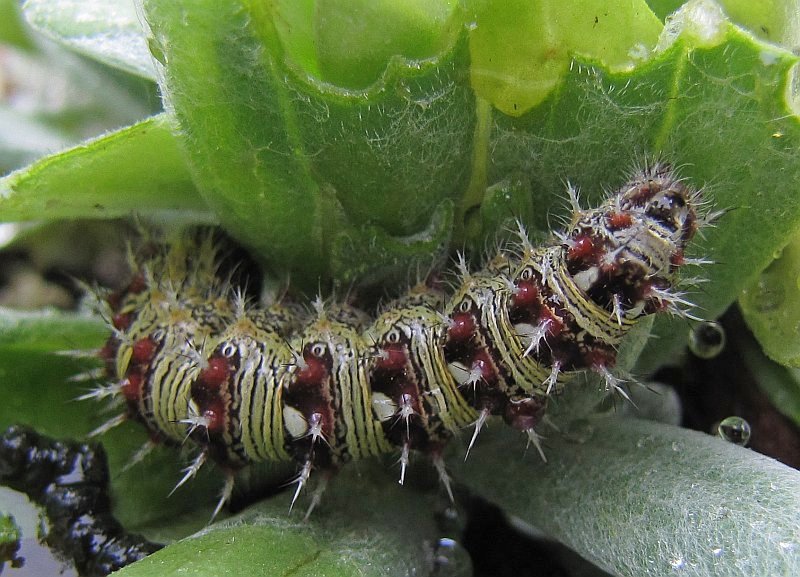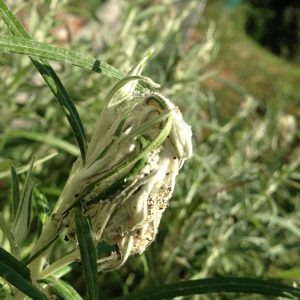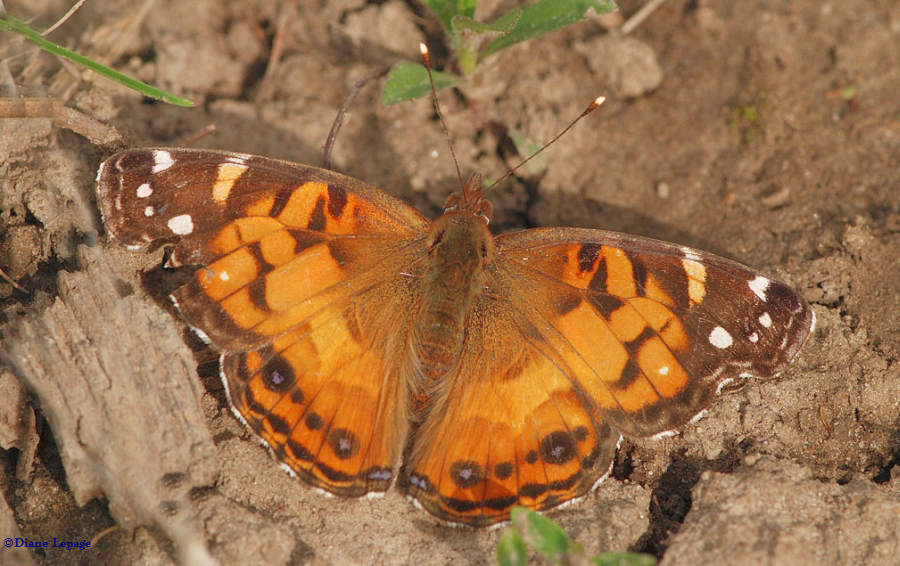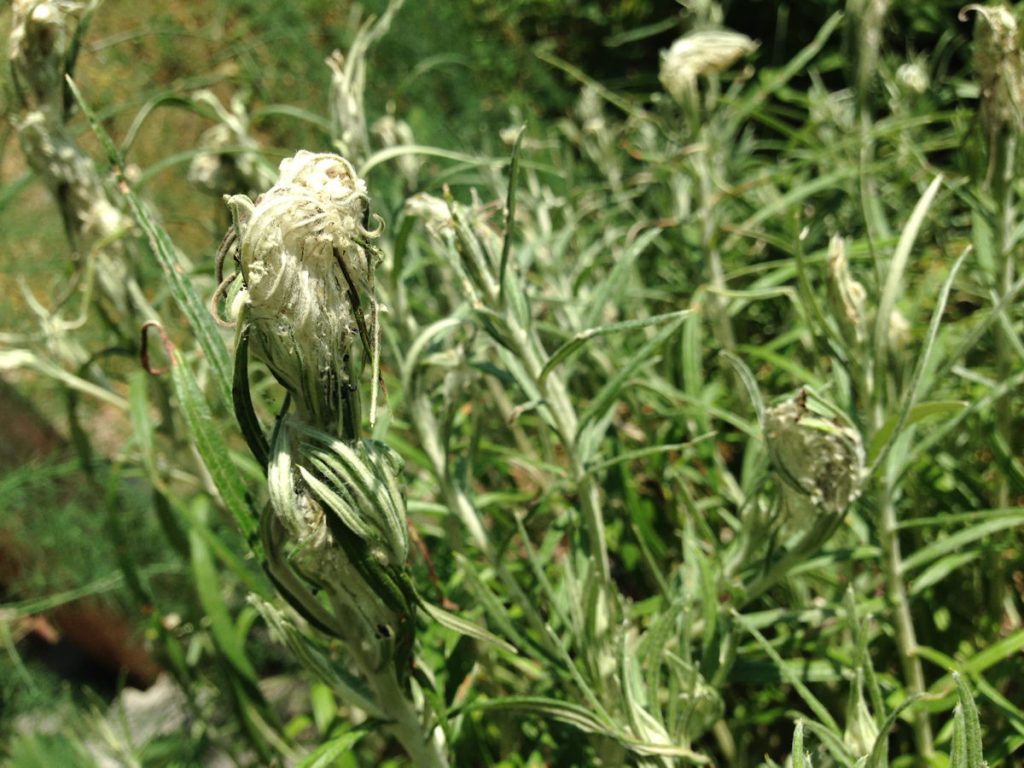by Renate Sander-Regier

The subtle elegance of Pearly Everlasting (Anaphalis margaritacea) flowers. Photo taken by Christine Hanrahan at the Fletcher Wildlife Garden.
In the spring of 2018, I planted a patch of Pearly Everlasting (Anaphalis margaritacea). I have long been charmed by the poetic, old-fashioned name of the plant, and by its demure, elegant flowers.
The plants I put into the ground were young, and I gave them lots of care to help them get a good start. This year they grew back in a dense cluster, with lush foliage. I was looking forward to the flowers.
But I did not, in fact, plant the Pearly Everlasting for its aesthetic appeal. I planted it for the ecosystem – specifically for the American Lady butterfly (Vanessa virginiensis), whose caterpillars feed on the hairy leaves of this plant, among others.

An American Lady caterpillar in a colourful late developmental stage, or “instar.” Photo by Christine Hanrahan.
I had planted the Pearly Everlasting in a sunny, sheltered spot that I thought would appeal to the butterflies – and it did. They came, although we didn’t see them. And they laid their eggs, although we did not see those either (I will look for them next year).
What we did notice, one day, were the leaves at the tips of certain plants stuck together. And then more leaves stuck together. I have since learned that the young caterpillars use silk and leaf fuzz to create these protective “tents,” usually at the ends of flower stalks.
The eggs seem to be hatching in waves in our Pearly Everlasting patch, with tiny black caterpillars in early developmental stages, or “instars,” munching not far from colourful late-instar caterpillars. It has been fascinating to watch.
Some sources state that the caterpillars rarely emerge in daylight, that they hide in their shelters during the day and come out to feed under cloudy conditions or at night. Yet I have been observing the caterpillars in our Pearly Everlasting patch in broad, sunny daylight. They must be in a hurry, very hungry. Although this behaviour has made observation easier, it has me worried, because it makes the caterpillars more vulnerable to the many birds in the vicinity who are always looking for a protein-rich meal.

A late-instar shelter, with leaves and flower heads pulled down into a more protective shape, and lots of frass.
As the caterpillars grew through their instars, so did the shelters. The late-instar caterpillars, larger and stronger, managed to pull together leaves and flower heads, sometimes bending them into more protective shapes.
The caterpillars kept growing, eating, and pooping. The shelters became larger, more secure, and filled with excrement, or “frass.” And the Pearly Everlasting patch became more ragged, more unsightly.
But I don’t mind. I planted the Pearly Everlasting for the caterpillars, the butterflies, the ecosystem.
And it’s working. The Pearly Everlasting patch is vigorous despite it ragged appearance. The caterpillars are growing and lively. If they don’t get eaten, they will enter the next stage to form a chrysalis, eventually emerging as a butterfly. I will keep my eyes open for those stages too.
A friend recently shared a quote that has been circulating on social media: “If something is not eating your plants, then your garden is not part of the ecosystem” (I have not, unfortunately, been able to trace the source).
That’s a good way of thinking about our gardens. They and other outdoor spaces we cultivate have the potential to play important roles in the natural world – meeting the needs of wild pollinators, for example, and other insects, as well as birds, small mammals, amphibians and reptiles, who all play important roles in the garden. The natural world, on its side, helps us meet so many of our needs.
And the relationship can be reciprocal. If we are generous with Mother Nature, she may be generous with us. In our Pearly Everlasting patch, she has been generous with caterpillars. She might even reward us with flowers.
Read more
Pearly Everlasting, Anaphalis margaritacea
- Canadian Wildlife Federation – Pearly Everlasting
- Gardening Know How – Growing Pearly Everlasting plants in the garden
American Lady butterfly, Vanessa virginiensis
- Butterflies of Canada – American Lady
- Butterflies and Moths of North America – American Lady
- University of Florida: Featured Creatures – American Lady
- Lepidoptera and their ecology – Vanessa virginiensis
Gardening for butterflies
- Fletcher Wildlife Garden – Gardening for butterflies
- Canadian Wildlife Federation – Gardening for butterflies
Butterfly and moth host plants (a little far from home, but lots of overlap with our region)
- The Native Plant Herald – Host plants for butterflies and moths
- Penn State Extension – Butterfly larval host plant list
Gardening and ecosystems
- The Conversation – Birds, bees and bugs: your garden is an ecosystem, and it needs looking after (the cover image is delightful)




really interesting. I planted Pearly Everlastings in two spots last spring. I will watch for the caterpillars!And try not to be sad if flwoers don’t arrive!
Our Pearly can get chewed down to half size, supports the caterpillars (eggs usually laid in late April/May) and then rebounds and blooms beautifully. Native flora, having co-evolved with native fauna, can be browsed and will still flower.